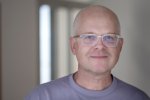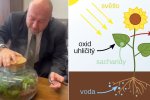Ženy vo vede a veda pre všetkých? vol. 7.

Ak ponúkneme ľuďom vedu zrozumiteľnou (občas aj hravou) formou, ona ich sama osloví. Žijemvedu preto pred letom vyhlásila súťaž na podporu a propagáciu vedy s názvom “Ženy vo vede a veda pre všetkých?”. Cieľom bolo v deťoch a mladej generácii podnietiť záujem o vedu a výskum. A chceli sme búrať mantinely stereotypov a prilákať do vedy viac mladých dievčat a chlapcov.
Súťaž bola v štyroch kategóriách: Mládež, Laická verejnosť, Odborníci a Nesúťažná kategória pre deti vo veku do 15. rokov. Stačilo zapojiť fantáziu, svoje vedomosti, súťaživosť a vypracovať zadanie na témy: “Osudové ženy vedy” alebo “Veda okolo nás” (viac info TU).
Do súťaže sme dostali viacero príspevkov (v anglickom jazyku) a časť z nich budeme v nasledujúcich týždňoch so súhlasom autorov zverejňovať. Výsledky súťaže a odovzdanie cien víťazom prebehne na výročnej konferencii Žijem vedu naživo 2019, ktorá sa bude konať už tento piatok.
Simona Veselá poslala svoj príspevok v rámci kategórie Odborníci – študenti VŠ, univerzít, začínajúci vedeckí pracovníci.
Science around us
Over the past couple of years, scientists have vigorously engaged in exploring and explaining the starting point of human presence on planet earth. There exist many theories of why and when we became a part of this beautiful world. Maybe you had the chance to come across the big bang theory, the theory of evolution or stories written in the Bible. These explanations were the cause of many fights in the past, each representing their own ultimate truth. Now, we know that even our belief of our own existence is determined in a certain manner. The existing scientific explanation suggests that belief is encoded in our DNA (Anderson et al., 2017). People don ́t believe in god, Buddhism, or some other mystical theories accidentally, it is our brain that creates a defense mechanism, „we believe in something“ to protect our mind from anxiety or depression (Miller et al., 2014). This means that humans are constrained by their own DNA, which can result in people resisting scientific progress.
Science is not only everywhere around us, but it ́s also in us, science is present in each of our cells. The way we look, how we behave, the potential health risks we may face or what we could become one day, is all encoded in our genetic code. This, however, doesn’t mean that the only factor responsible for your behavior, the path you take in life are your genes. The person we are or potentially might become is the result of a mixture of our genetics and other environmental factors.
Moving away from the egoistic part of our genetic code and human existence, there are so many other forms of life that we have not yet been able to fully understand. Yesterday, I discovered a whole new ecosystem in my own turtles‘ tank. I observed thousands of living Chironomid Midges in a larval stadium. I was trying to explain how could these Chironomids possibly enter the tank as my windows are secured with mosquito nets. Many possibilities came into my mind, however, there was no clear explanation. Then, I remembered that a few weeks ago for the very first time I fed my tortoises with a frozen mixture of mosquito larvae, placing them directly in their pond. I couldn’t believe they survived the frozen state. Impossible, considering their damaged tissues and DNA caused by water crystals during their freezing process. Since I wasn’t fully convinced I decided to read various publications and recent studies concerning these creatures. The information present in these publications showed, that Chironomids have a high level of tolerance to various extreme environmental conditions including hypoxia, low temperatures and high salinity (Armitage et al., 1994). With this in mind, I was able to find something more specific and bring my sci-fi hypothesis to life. Chironomids have a tiny genome. According to Cornette et al. (2015) there is a probability that, „the result of an ancestral reduction of the number of transposable elements and of the length of introns in their genome structure. The small genome size of chironomids theoretically could have constituted a preadaptation to unstable and extreme environments through high developmental rate and low mutation rate“. Chironomids are also able to manage extreme temperatures reaching up to -16 °C while undergoing the rehydration process. The thought that these tiny, highly adaptable and strong survivors are living with me in one room is just fascinating.
Please have a moment and stop for a while, to look around you. There is a high chance you would find so many scientific phenomenons, reminding us of how little we still know about the world we live in.
Anderson MR, Miller L, Wickramaratne P, et al. Genetic Correlates of Spirituality/Religion and Depression: A Study in Offspring and Grandchildren at High and Low Familial Risk for Depression. Spiritual Clin Pract (Wash D C ). 2017;4(1):43–63. doi:10.1037/scp0000125
Cornette R, Gusev O, Nakahara Y, et al. Chironomid midges (Diptera, chironomidae) show extremely small genome sizes. Zoolog Sci. 2015; 32(3):248-54. doi: 10.2108/zs140166.
Miller L, Bansal R, Wickramaratne P, et al. Neuroanatomical correlates of religiosity and spirituality: a study in adults at high and low familial risk for depression. JAMA Psychiatry. 2014;71(2):128–135. doi:10.1001/jamapsychiatry.2013.3067
O autorke:
Simona Veselá bio:
New ideas enthusiast
Absolventka vysokoškolského štúdia na Prírodovedeckej fakulte UK na Katedre Genetiky. S vášňou pre biotechnológie. Páči sa jej predstava využitia biologických procesov prebiehajúcich v živých mikroorganizmoch na produkciu ľudstvu prospešných látok.
Počas štúdia pracovala v laboratóriu na Prírodovedeckej fakulte UK, kde sa venovala identifikácii funkcie modifikovaných proteínov v kvasinkách. Vyskúšala si tiež prácu v kvasinkovom laboratóriu na Karlovej Univerzite v Prahe. Bola jedným z prvých členov slovenského start up-u DNA ERA.
V rámci vízie s tímom vyvíjajú aktivity na podporu a rozvoj vedeckého prostredia na Slovensku. Momentálne pracuje na dvoch projektoch, ktoré môžu pomôcť vede na Slovensku. Jedným z nich je Night of Chances Science a začínajúca platforma Biospher. V rámci platformy Biospher sa snaží vytvoriť inšpiratívne prostredie, ktoré umožní šikovným ľuďom a zaujímavým projektom z oblasti biotechnológie a mikrobiológie rozvinúť sa tak, aby sa uchytili na trhu. Cez rôzne aktivity sa v rámci Biopsher snažia nielen popularizovať vedu, ale tiež budovať komunitu fanúšikov vedy, ktorí chcú rozvíjať seba, vedu a vzájomne si pomáhať. Momentálne organizujú popularizačné prednášky a stretnutia v menších skupinách. V novom roku by sa radi začali venovať komplexnejším projektom ako sú workshopy alebo hackhatony.

















